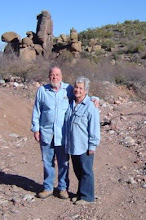12/24/06
I suppose by a stretch of the imagination and following the definition of what a ghost town is, these have to be some of the oldest ones around this part of the country.
The Salado Indians inhabited much of the land throughout Arizona, during 1280s up until somewhere around 1350. They were farmers and gatherers for the most part and lived in cliff dwellings carved and built high up on canyon walls. Their perches enabled them to see if enemies were approaching and also gave them a vantage point to watch for any game that might come their way. The trees and heavy brush hid the dwellings from anyone walking the path below.
We visited one of these ruins on Christmas Eve with our friends Larry & Jean, their son and two granddaughters. A nice way to spend the holiday. We drove in as far as we could then hiked the 2+ miles to the ruins. It was a bit of a scramble up the steep path leading to the ruins, but we were rewarded with a super location to explore. The walls and ceilings built into the cliffside were made of stone and mud mortar, supported by long logs. In some places we could still make out the almost 700 year old fingerprints left in the mortar. Blackened stones overhead indicated the fires the ancients used for heating and cooking. From the interior of one of the rooms, we could see that at one time there were several levels of living space. The particular dwellings we visited are located high above Coon Creek in the Sierra Anchas of Arizona. Below the dwellings, along Coon Creek, the land was flat and easily irrigated by the waters of the creek were where the Salados did their farming.
The Salado Indians inhabited much of the land throughout Arizona, during 1280s up until somewhere around 1350. They were farmers and gatherers for the most part and lived in cliff dwellings carved and built high up on canyon walls. Their perches enabled them to see if enemies were approaching and also gave them a vantage point to watch for any game that might come their way. The trees and heavy brush hid the dwellings from anyone walking the path below.
We visited one of these ruins on Christmas Eve with our friends Larry & Jean, their son and two granddaughters. A nice way to spend the holiday. We drove in as far as we could then hiked the 2+ miles to the ruins. It was a bit of a scramble up the steep path leading to the ruins, but we were rewarded with a super location to explore. The walls and ceilings built into the cliffside were made of stone and mud mortar, supported by long logs. In some places we could still make out the almost 700 year old fingerprints left in the mortar. Blackened stones overhead indicated the fires the ancients used for heating and cooking. From the interior of one of the rooms, we could see that at one time there were several levels of living space. The particular dwellings we visited are located high above Coon Creek in the Sierra Anchas of Arizona. Below the dwellings, along Coon Creek, the land was flat and easily irrigated by the waters of the creek were where the Salados did their farming.
This must have been the same view the ancient Salado Indians had
Stones and mud mortar
From the inside looking out
Wonderful colors!
From here we could see that at one time, there were several levels to the living quarters.
